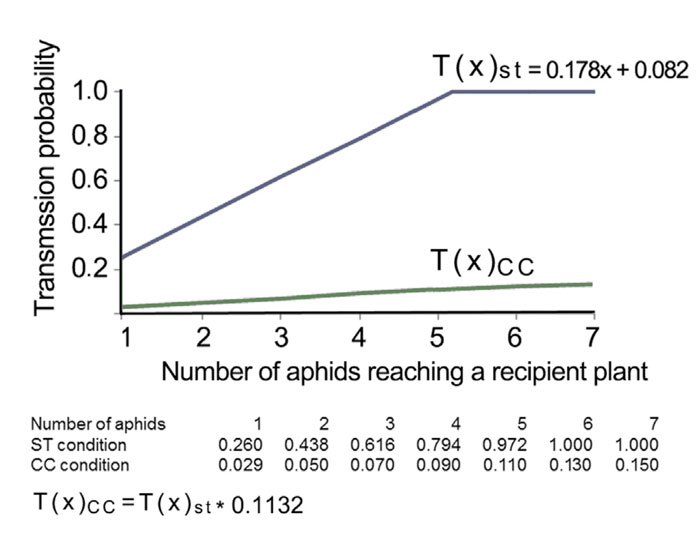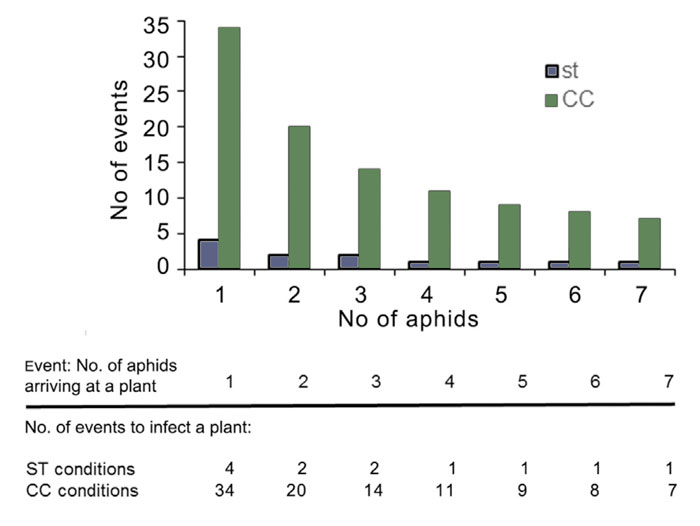| Tweet | Follow @co2science |
Paper Reviewed
del Toro, F.J., Choi, K.S., Rakhshandehroo, F., Aguilar, E., Tenllado, F. and Canto, T. 2019. Ambient conditions of elevated temperature and CO2 levels are detrimental to the probabilities of transmission by insects of a Potato Virus Y isolate and to its stimulated prevalence in the environment. Virology 530: 1-10.
Plant viruses cause extensive damage to crops every year. Most such viruses are transmitted via insects, who feed on infected plants and then pass viruses on to uninfected ones. When it comes to projections of future climate change, much remains to be learned on the topic.
Hoping to add some understanding in this regard, del Toro et al. (2019) recently examined the probability of transmission of potato virus Y by the peach aphid (Myzus persicae) to Nicotiana benthamiana plants subjected to either (1) present-day temperatures (25°C) and atmospheric CO2 levels (405 ppm), referred to as the standard treatment (ST) or (2) future-projected temperatures (30°C) and CO2 levels (970 ppm), referred to as the climate change (CC) treatment.
Results indicated that when the experimental environment included 3 virus-infected aphids, transmission frequencies were 88% lower in the CC treatment (6.3% transmission rate) compared to the ST treatment (52.5% transmission rate). Similar findings were observed using fewer (1 or 2) or more (4) aphids per recipient plantlet, where virus transmission rates in the ST treatment were always significantly higher than those in the CC treatment.
But this was not all the authors reported.
Using the data obtained in the first stage of their experiment as described above, del Toro et al. next sought to "calculate transmission probabilities from either ST or CC donor [infected] leaves for different numbers of aphids probing on [uninfected] recipient plantlets." The resultant probabilities are shown in Figure 1 below. As revealed there, the probability of a single aphid transmitting the virus after feeding on an infected plant in the ST treatment is 26% (0.260), whereas in the CC treatment it is a much lower 2.9% (0.029). These probabilities rise as more aphids are introduced into the equation such that when there are five aphids having the potato virus Y probing on a plant, the probability of virus transmission to the uninfected plant reaches 100% in the ST treatment. However, in the CC treatment, 100% infection probability is not reached until the number of infected aphid events on a given plant reaches a whopping 34, a value far off the graph!
Figure 2 presents a graph of the average number of first-time probings by aphids on recipient plants after having fed on leaves of infected plants in the two temperature and CO2 treatments that are required to contaminate the uninfected plant, relative to the number of aphids that reach each recipient plant. Using the data presented in this figure, del Toro et al. determined that in the ST treatment a visitation rate of 1.10 aphids per plant in a week was "sufficient to maintain potato virus Y in a simulated environment," whereas a visit of 4 aphids per plant per week was enough to ensure maximum transmission/plant infection. In contrast, the researchers determined that "the virus disappeared from the environment when less than 10 aphids (9.881) visited each plant in a week" in the CC treatment, and they note that "only with values equal to or greater than 10 visiting aphids/plant/week infection became endemic, although with percentages of infection much lower than under ST conditions."
Thus, given the above calculations and findings, the authors conclude that "conditions of elevated ambient temperature and CO2 levels decreased probabilities of transmission of viral infection by aphids," which suggests that "extended warm episodes and permanent elevated levels of CO2 associated [with] climate change could challenge the prevalence of infections by some populations of non-persistently transmitted potyviruses." And that is wonderful news for plants routinely subjected to such.

Figure 1. The observed proportion of non-persistent transmission of viral infection by a given number (x) of aphids that fed on donor leaves from Nicotiana benthamiana plants infected by a potato virus Y isolate kept under ST or CC conditions, relative to the number of aphids that reached and probed on each recipient plantlet. Source: del Toro et al. (2019).

Figure 2. The average number of events (first-time probings by aphids on recipient plantlets after having fed from leaves of infected plants kept under ST or under CC conditions) required to infect a Nicotiana benthamiana plantlet relative to the number of aphids that reach each recipient plantlet. Source: del Toro et al. (2019).




